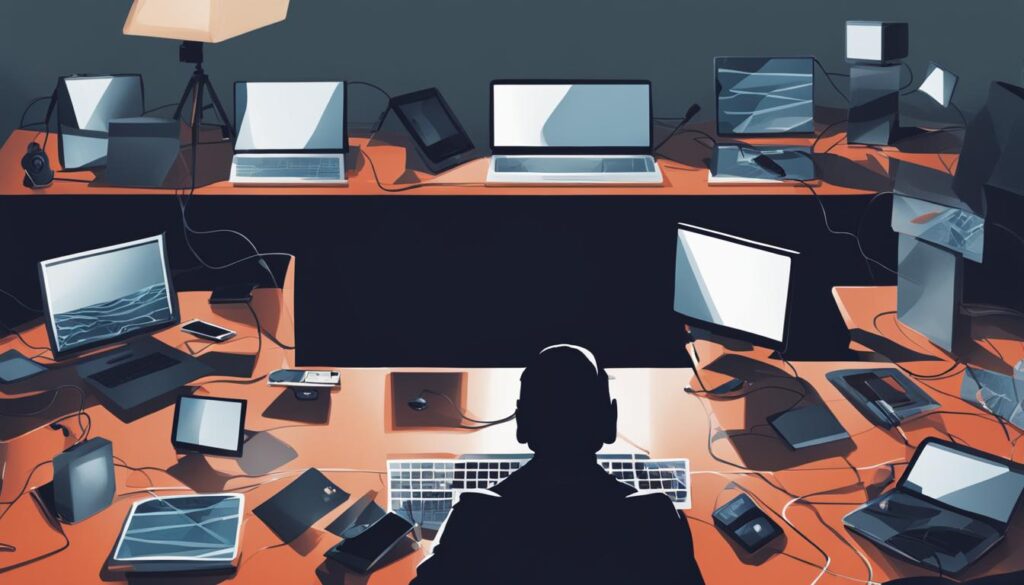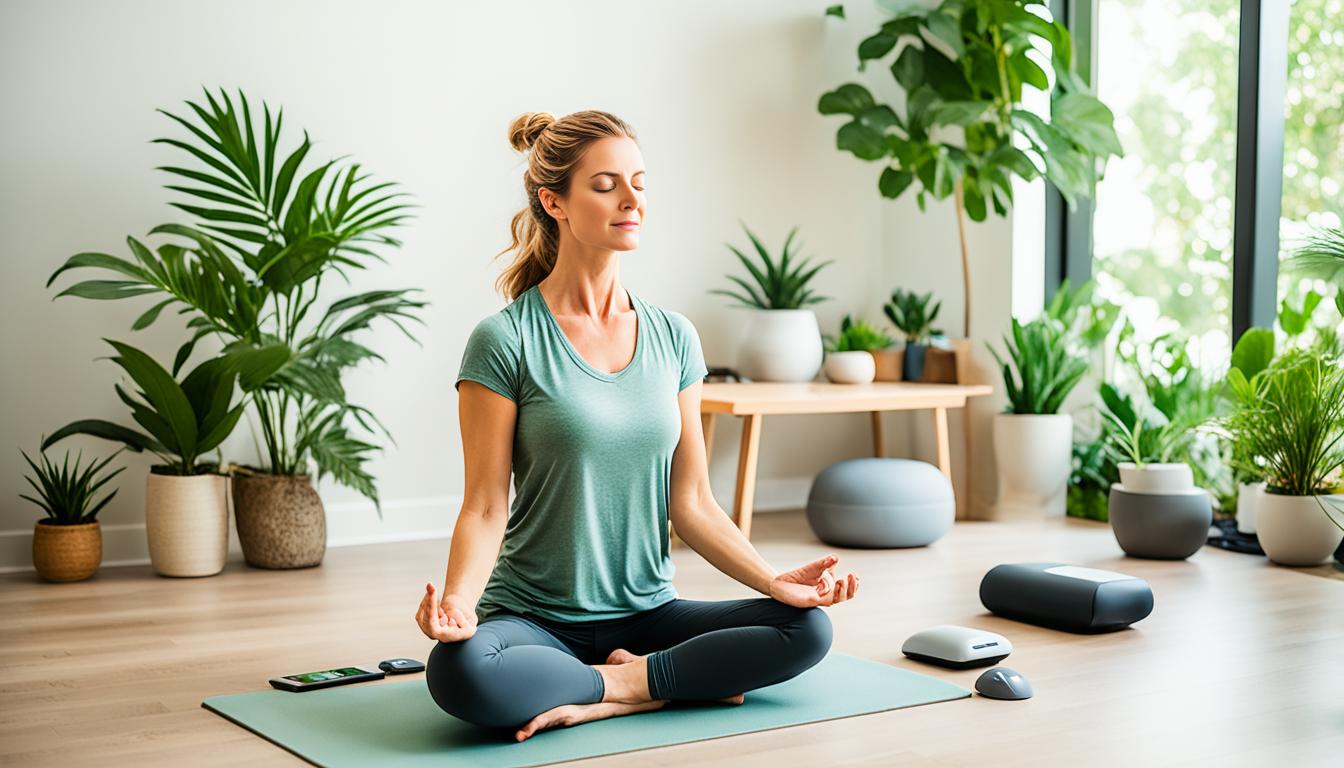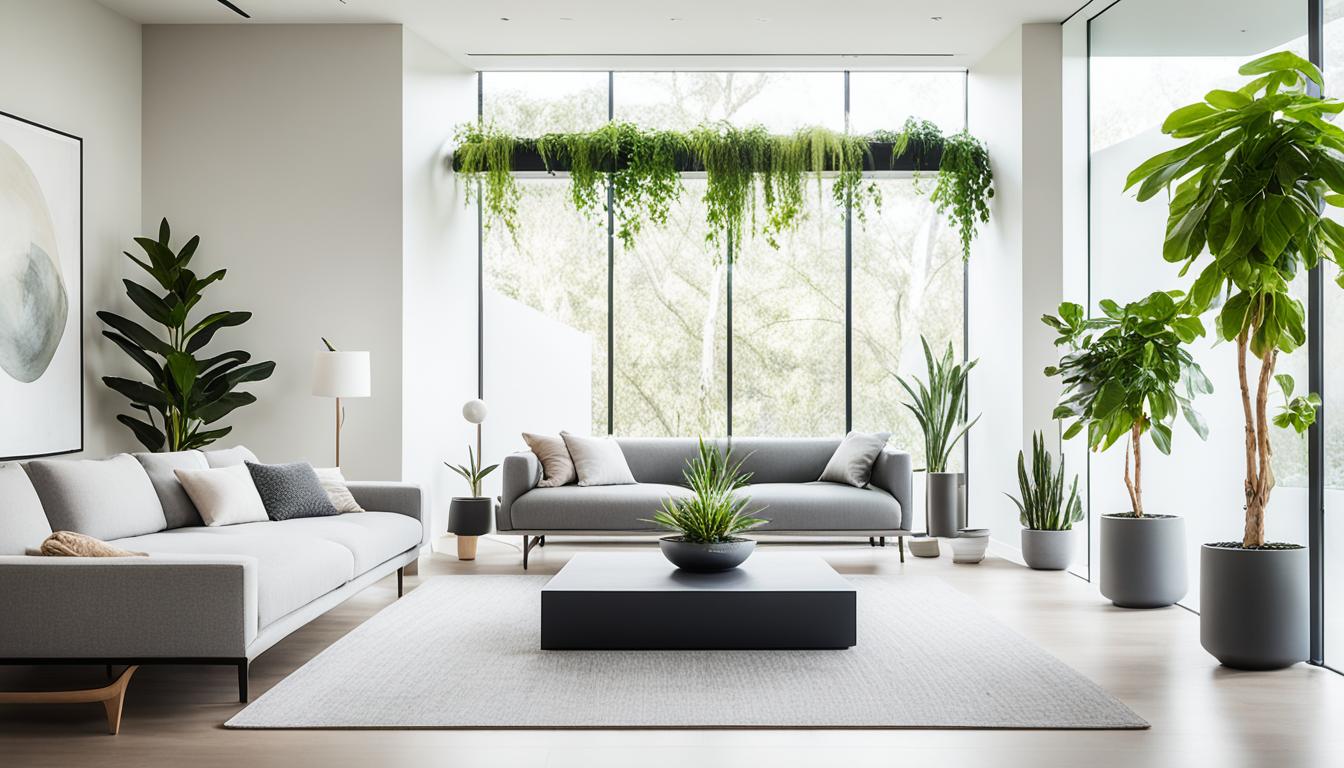Disclosure: This Post Contains Affiliate Links; We earn a commission on purchases.
Modern technology has revolutionized the way we live, offering convenience and endless information at our fingertips. However, as our reliance on technology grows, so does the need for balance. Achieving a healthy relationship with our devices involves managing our technology use effectively while reaping the benefits it offers.
Key Takeaways:
- Striking a balance in technology use is essential for our well-being.
- Managing device usage can reduce stress and increase productivity.
- Setting boundaries and establishing healthy habits are crucial in finding a technology balance.
- Excessive technology use can have negative effects on our health.
- Achieving a balanced tech-life relationship leads to improved happiness and fulfillment.
Strategies for Managing Tech Use
To achieve a healthy relationship with technology, it is important to implement effective strategies for managing tech use. By incorporating the following tips into your daily routine, you can promote digital wellness and develop healthy tech habits.
- Avoid using phones while driving to prevent distractions and accidents.
- Limit smartphone use at night to improve sleep quality. The blue light emitted by devices can disrupt sleep patterns.
- Turn off notifications to reduce distractions and promote focus and productivity.
- Manage expectations by communicating your availability and response times to others.
- Use social media actively rather than passively to enhance well-being.
- Be present in face-to-face interactions and minimize distractions from devices.
- Take regular breaks from technology to recharge and promote relaxation.
By implementing these screen time limits and practicing digital balance, you can create a healthier relationship with technology and enhance your overall well-being.
Establishing Healthy Habits
Taking control of your tech habits requires establishing healthy habits:
Set a technology use policy that aligns with your priorities and promotes quality time with loved ones.
Create designated no-tech zones where devices are not used to encourage communication and other non-tech activities.
Limit technology use at specific times of the day to avoid excessive screen time.
Develop a new routine that includes scheduled email checking and setting boundaries during holidays and time off.
Take advantage of technology resources for physical exercise, such as fitness apps and online workouts.
Establishing these healthy habits will help you maintain device management and ensure mindful tech usage. It’s important to find a balance between technology and the other aspects of your life to prioritize your well-being and maintain a healthy relationship with devices.
Find Your Balance
“The real problem is not whether machines think but whether men do.” – B.F. Skinner
The Importance of a Tech-Life Balance
Striking a balance between technology and life is crucial for overall well-being. In today’s digital age, where technology has become an integral part of our daily lives, it is essential to recognize the impact it can have on personal connections, relationships, and mental health. Developing a healthy tech-life balance is the key to finding fulfillment and maintaining a sense of well-being.
Excessive technology use can have negative consequences on our personal lives. Constant digital distractions can hinder meaningful interactions with loved ones, leading to a breakdown in communication and a loss of connection. It is important to be mindful of the time spent on devices and prioritize quality time with family and friends.
A tech-life balance also plays a significant role in maintaining good mental health. Overreliance on technology can contribute to feelings of anxiety, stress, and even depression. Being constantly connected to devices can create a sense of constant pressure and the fear of missing out. By establishing boundaries and consciously disconnecting from technology, we can create space for relaxation, self-reflection, and a healthier state of mind.
The Rewards of a Tech-Life Balance
When we find a healthy balance between technology and our personal lives, the rewards are numerous:
- Improved Health: Spending less time in front of screens can help alleviate common issues associated with excessive technology use, such as eye strain, posture problems, and sedentary behavior.
- Enhanced Relationships: Prioritizing face-to-face interactions and quality time with loved ones strengthens relationships and fosters deeper connections.
- Increased Productivity: By managing technology use effectively, we can minimize distractions and improve our focus, leading to increased productivity and efficiency in our daily tasks.
- Enhanced Well-being: Disconnecting from technology allows us to engage in activities that bring us joy and fulfillment, such as hobbies, exercise, and spending time in nature.
Achieving a tech-life balance is a continuous process that requires conscious effort and self-awareness. By setting boundaries, managing screen time, and prioritizing offline experiences, we can create a healthier relationship with technology and find harmony in our daily lives.
Remember, a healthy tech-life balance is essential for your overall well-being. Take the time to evaluate your relationship with technology and make intentional choices that prioritize meaningful connections, mental health, and personal fulfillment. By finding the right balance, you can enjoy the benefits of technology while maintaining a fulfilling and rewarding life.
The Effects of Excessive Technology Use on Health
Regular use of technology can have various negative effects on health, including:
- Vision problems caused by prolonged screen time, leading to dry eyes, blurry vision, and diminished eyesight.
- Insomnia and disturbed sleep patterns due to exposure to the blue light emitted by screens.
- Obesity, as excessive tech use often correlates with a sedentary lifestyle.
- Potential hearing problems from prolonged use of headphones or loud audio.
It is important to be aware of these health risks and make conscious efforts to mitigate them.

Dr. Sarah Williams, an ophthalmologist at Clear Sight Eye Clinic, emphasizes the importance of reducing screen time to maintain healthy vision. She explains, “Prolonged exposure to screens can strain our eyes, causing dryness, blurred vision, and even long-term damage. It’s crucial to take regular breaks and practice the 20-20-20 rule: every 20 minutes, look at something 20 feet away for 20 seconds.”
Recognizing the Need for Change
As technology continues to advance, it is crucial to acknowledge its impact on personal development and interactions. Our overdependence on devices, constant pursuit of entertainment, and desire for instant gratification can hinder independent thinking and hinder our ability to connect with others.
Taking regular breaks from devices and reevaluating our technology needs can lead to a more fulfilling and enriching life. By recognizing the negative effects of excessive digital distractions, we can prioritize personal growth and meaningful connections. It’s time to make a change.

Disconnect to Reconnect
In today’s fast-paced digital world, taking unplugged breaks is more important than ever. Spend time engaging in activities that foster personal development, such as reading a book, pursuing a hobby, or taking a walk in nature. By disconnecting from technology, we can reconnect with ourselves and others on a deeper level.
“The real magic happens when we step away from the screen and experience the richness of the world around us.”
– John Smith, Digital Wellness Expert
Embrace Mindfulness in the Digital Age
Mindfulness is a valuable practice that can help combat the negative impact of technology on personal development. By being fully present in the moment and aware of our digital habits, we can consciously choose when and how to engage with technology. Mindfulness empowers us to make intentional decisions and nurture personal growth.
Set Boundaries and Prioritize Personal Growth
Establishing clear boundaries is essential for personal development in the age of technology. Create designated times and spaces where devices are off-limits, allowing for uninterrupted self-reflection and growth. By prioritizing personal development over digital distractions, we can unlock our full potential.
Conclusion
Achieving a balanced technology use requires conscious effort and the establishment of healthy habits. By implementing strategies such as setting boundaries, creating no-tech zones, and being mindful of technology’s impact on health, it is possible to strike a balance between digital connectivity and personal well-being.
Prioritizing quality time with loved ones and engaging in offline activities are integral parts of a healthy tech-life balance. By putting devices aside and being present in face-to-face interactions, we can strengthen our relationships and foster deeper connections.
Taking regular breaks from devices is also crucial for our overall well-being. Periods of digital detox allow us to recharge, relax, and reconnect with ourselves. It’s during these breaks that we can truly appreciate the world beyond screens and find tranquility in the present moment.
In today’s fast-paced world, finding a healthy relationship with technology is key to promoting digital wellness. By adopting healthy tech habits, we can enjoy the benefits of digital technology while safeguarding our physical and mental health. Striving for a balanced technology use empowers us to live a more rewarding and fulfilling life.
Source Links
- https://www.totalphase.com/blog/2016/12/tips-balance-technology-usage/
- https://www.apa.org/topics/social-media-internet/healthy-technology-use
- https://www.uhcglobal.eu/wellbeingatwork-blog/finding-a-healthy-balance-with-devices

Subscribe to Our Newsletter










